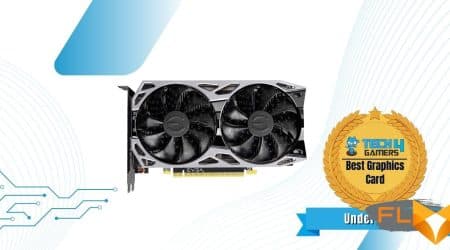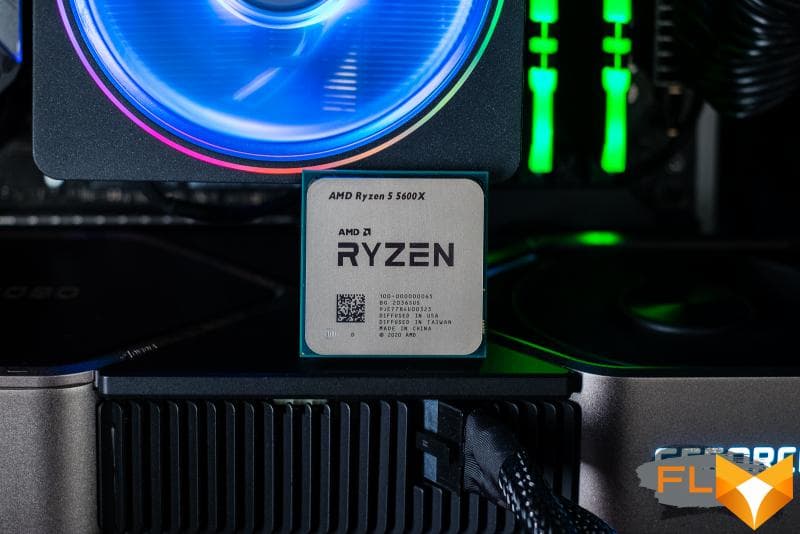


In the Ryzen 3000 series of desktop processors, the most popular model by a wide margin was, and still remains, the younger six-core Ryzen 5 3600. Having enough cores and threads for most modern tasks, it has a low (below $200) price and is pretty good for its value for its performance, which made it almost the standard choice of 2020 for mainstream gaming configurations. Moreover, even the appearance of worthy alternatives in the face of the Core i5-10400 and i5-10400F could not reverse this trend.

From the manufacturer’s point of view, such an assessment of the new processor with six cores is quite justified. In the new generation of processors, operating frequencies have increased by several hundred megahertz and specific performance has increased by 19%, which means that in terms of processing power, the Ryzen 5 5600X should be similar to the representatives of the Ryzen 3000 series with eight cores, which just reflects its price. Moreover, if we compare the Ryzen 5 5600X with its counterparts, it turns out that one core in it is even 20% cheaper than in the Ryzen 7 5800X, and this can also be considered an argument in favor of AMD not going too far with the price.
But all this still contrasts strongly with what AMD itself taught us. Market success for Ryzen processors initially came due to the company’s strategy to give more for less budget. And until recently, its processors offered more advanced multithreading than competing Intel offerings of the same price. Now the situation is reversed: the Ryzen 5 5600X is a quarter more expensive than the older six-core Intel without integrated graphics, the Core i5-10600KF.
In the future, the Ryzen 5000 series will probably have cheaper processors than the Ryzen 5 5600X. But apparently, this will have to wait a long time, because so far it is very difficult to buy existing models – AMD is clearly unable to meet demand. And this clearly indicates that buyers are ready to pay $300 for a six-core processor, although for the same amount one could easily purchase an eight-core Core i7-10700F. In this review, we will try to understand if the Ryzen 5 5600X is really so successful that it really deserves the amount that AMD is asking to pay for it. Or is it just that the company managed to accumulate a critical mass of fans who are ready to overpay for the opportunity to quickly get their hands on the next “hot” new product?
⇡#Ryzen 5 5600X in detail
The Ryzen 5 5600X is currently the only six-core representative in the Ryzen 5000 lineup. This processor supports SMT technology, which means it offers a 6/12 core formula similar to the predecessors Ryzen 5 3600XT, 3600X and 3600. It does not differ from them in terms of total volume cache memory of the third level, which is 32 MB.
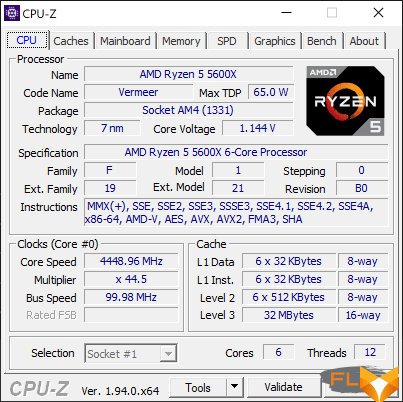
In the new lineup, the Ryzen 5 5600X occupies a special place, and it’s not just the number of cores, in which the Ryzen 5 5600X is the junior model. This processor is the only one among its brethren that has a thermal package of not 105, but 65 watts. That is, it is more economical and colder, which is also confirmed by the limited power consumption of 88 W. Thanks to this, it can easily determine a place in compact and economical systems where older Ryzen 5000s are unlikely to take root. AMD was not even afraid to put a complete cooler in the box with the Ryzen 5 5600X – a simple aluminum Wraith Stealth, which the company previously offered with the Ryzen 5 3600.
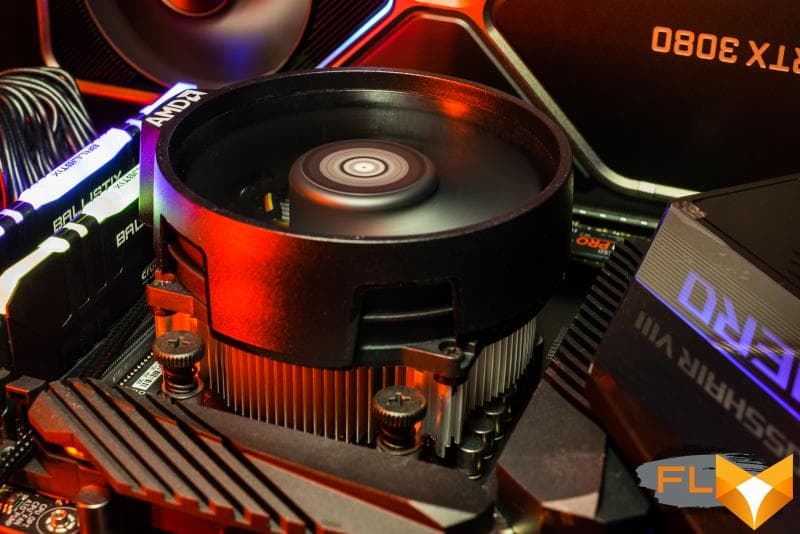
Judging by the specs, AMD didn’t have to make any noticeable compromises in terms of frequencies to achieve cost-effectiveness. The base frequency for the Ryzen 5 5600X is set to 3.7 GHz, and the maximum frequency in turbo mode is limited to 4.6 GHz. Both values are 100 MHz lower than the corresponding frequencies of the eight-core Ryzen 7 5800X, but the Ryzen 5 5600X bypasses the older 95-W six-core of the previous generation in maximum frequency. This can be seen from the table of characteristics, in which, in addition to the six-core carriers of the Zen 2 and Zen 3 microarchitectures, we also included the current Intel six-core processor, the Core i5-10600K, for comparison.
| Ryzen 5 5600X | Ryzen 5 3600XT | Ryzen 5 3600 | Core i5-10600K | |
|---|---|---|---|---|
| Platform | Socket AM4 | Socket AM4 | Socket AM4 | LGA1200 |
| Microarchitecture | Zen 3 | Zen 2 | Zen 2 | Skylake |
| Technological process, mm | 7/12 | 7/12 | 7/12 | 14 |
| Cores/Threads | 6/12 | 6/12 | 6/12 | 6/12 |
| Frequency (nominal/turbo), GHz | 3.7-4.6 | 3.8-4.5 | 3.6-4.2 | 4.1-4.8 |
| L3 cache, MB | 32 | 2 × 16 | 2 × 16 | 12 |
| TDP, W | 65 | 95 | 65 | 95 |
| Memory | DDR4-3200 | DDR4-3200 | DDR4-3200 | DDR4-2933 |
| PCIe lanes | 24 × Gen4 | 24 × Gen4 | 24 × Gen4 | 16 × Gen3 |
| Integrated Graphics | No | No | No | Yes |
| Price | $299 | $249 | $199 | $262 |
Unlike its competitor, AMD does not name the maximum frequencies achieved by processors when loaded on a specific number of cores: everything is decided locally and determined by temperatures and consumption. In other words, different instances of the same processor on different systems may perform slightly differently. But in order to get a rough idea of what frequencies to expect from the Ryzen 5 5600X under various loads, we checked our CPU instance and plotted its real frequency versus the number of cores and threads loaded with work. The Cinebench R23 rendering test was used as a load in its construction.

Experimental data shows that the Ryzen 5 5600X is capable of operating at a slightly higher clock speed than the maximum clocked in the specs. Moreover, this processor keeps the frequency of 4.65 GHz not only when loading one core, but also in a much wider range of loads: in fact, the frequency starts to decrease only when the number of involved threads exceeds eight. At the same time, in rendering using all the computing resources of the processor, the minimum frequency was 4.425 GHz, that is, it is legitimate to talk about an increase in the real frequency compared to the Ryzen 5 3600XT by 100-200 MHz.
But more than frequencies, the new six-core is interesting with the new Zen 3 microarchitecture. You can find a detailed story about it in the review of Ryzen 9 5950X and Ryzen 9 5900X, and here we just recall that IPC grew by 19%, and the most striking moment was the merger two CCX-complexes inside each eight-core semiconductor crystal into a single structure. As a result, the cache memory in processors with eight and six cores no longer consists of two independent halves, but is a single whole, and each computing core has full and equal access to it. This speeds up the entire memory subsystem and reduces delays in inter-core data exchange, which has a positive effect on performance in a wide range of tasks, and especially in 3D games.
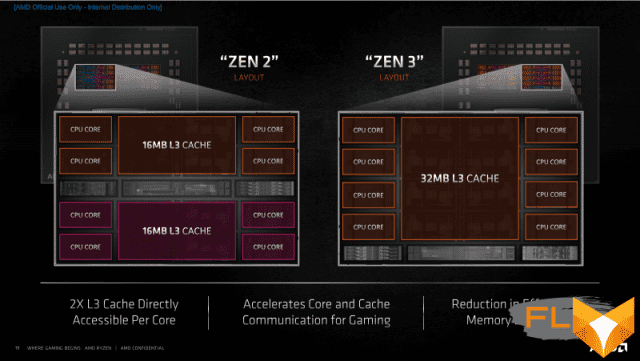
The six-core Ryzen 5 5600X, like the eight-core Ryzen 7 5800X, is assembled from two semiconductor crystals. All computing cores are located in a 7nm CCD chiplet, which consists of 4.15 billion transistors and has an area of 80.7 mm2. This die is standard on all Zen 3s and has eight cores and 32MB L3 cache, but the Ryzen 5 5600X uses two hard-locked dies. Thanks to this, AMD is able to use partially defective silicon with single defects in the Ryzen 5 5600X.
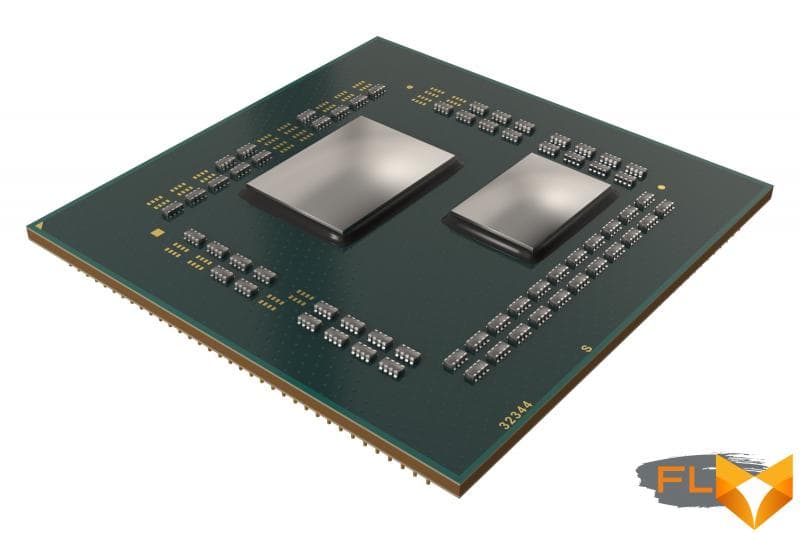
The second die is a 12nm I/O chiplet, which is inherited from the previous generation of processors and consists of 2.09 billion transistors placed on an area of 125mm2. Communication between semiconductor crystals in the processor is provided by the Infinity Fabric bus, which is now completely unloaded from inter-core traffic and is actually only responsible for the interaction of computing cores with DDR4 SDRAM and PCI Express 4.0 controllers.
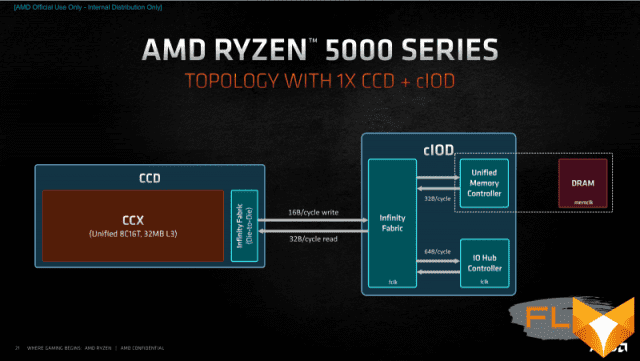
Due to the fact that some part of the CCD chip in the Ryzen 5 5600X is disabled, and, in addition, the consumption of this processor is limited to a lower bar than in the case of other members of the Ryzen 5000 series, it operates at relatively low temperatures. However, this does not apply when the system uses the stock cooler out of the box, the Wraith Stealth. Its performance for heat dissipation from the Ryzen 5 5600X is purely conditional: in this case, the user is invited to come to terms with the fact that under any serious load, the processor will reset its frequency in order to avoid overheating. For example, our CPU with Wraith Stealth installed ran at only 4.2 GHz when rendering in Cinebench R23, while with normal cooling, the same test Ryzen 5 5600X is able to pass at over 4.4 GHz.
Ryzen 5 5600X with Wraith Stealth cooling in Cinebench R23
Therefore, we would not recommend relying on a boxed cooler – it cuts the performance of the Ryzen 5 5600X, and quite noticeably.
Although the Ryzen 5 5600X can’t be called a budget offering, continuity is still important for it – the ability to work in old Socket AM4 motherboards. AMD has promised that Ryzen 5000 will be compatible with any 500-series chipset boards (X570, B550, and A520) after a BIOS update, while 400-series chipset boards will have limited compatibility with new Ryzen next year. However, the reality turned out to be even better: motherboard manufacturers were able to implement support for the Ryzen 5 5600X with comrades in many older platforms faster than expected. A large number of boards based on the X470 and B450 chipsets can already today be easily accepted on board the Ryzen 5 5600X. But you need to remember that they do not support PCI Express 4.0, while this version of the interface has already become widespread in modern graphics cards and solid state drives.
⇡#Overclocking
We are already quite familiar with the overclocking process of the older representatives of the Ryzen 5000 family, and in general, the same principles that were formulated earlier are true for them: Precision Boost technology copes well with automatic frequency control in normal mode, independently transferring these processors to states close to to the limit of silicon. And most importantly, with low-threaded loads, it sets processor frequencies that are simply unattainable in manual overclocking with synchronous clocking of all cores. All this makes the usual overclocking of AMD processors not very productive.
However, in the case of the Ryzen 5 5600X, the situation is somewhat different. The operating frequencies of this processor are further limited by the strict requirements of the 65-watt thermal package, and their cancellation can make it a less promising object for overclocking.
In confirmation of these words it is possible to present a practical result. Our copy of the Ryzen 5 5600X ran at a fixed frequency of 4.65 GHz without any problems and remained stable at it when loading all the cores.
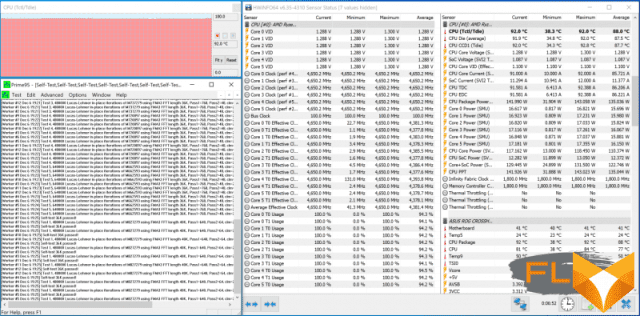
The voltage required to maintain stability in the Prime95 30.3 stress test was 1.3 V when the fourth level of the Load-Line Calibration function was selected. According to in-processor monitoring, under load, it dropped to 1.288 V, and CPU consumption increased to 142 watts. At the same time, the processor temperature remained within 92 degrees, however, for cooling in this case, a self-assembled LSS from EKWB components with a 360 mm form factor radiator was used.
It cannot be said that in this case we managed to conquer some impressive heights, but the significant thing here is that the synchronous overclocking of all cores at the same time made it possible to reach the frequency that the processor independently develops under a single-threaded load. And this means that manual overclocking of the Ryzen 5 5600X will not lead to a decrease in performance when executing low-threaded computational algorithms.
And one more important point: the Ryzen 5 5600X turned out to be the most overclocked processor in the entire Ryzen 5000 family. Overclocking of any of the representatives of this family rests on high operating temperatures. But the Ryzen 5 5600X isn’t as hot out of the box as its higher core count brethren, so it gives you more room to increase the frequency.
However, the main surprise of the Ryzen 5 5600X presents when overclocked using Precision Boost Override technology. It turns out that it is enough to give this processor complete freedom in terms of heat dissipation and power consumption, and its frequency will immediately rise by 200-300 MHz, while maintaining dynamic auto-tuning. For example, our copy, when Precision Boost Override was enabled in a single-threaded load, earned at 4.95 GHz, and with a multi-threaded load it could keep the same 4.65 GHz that we received in manual overclocking.
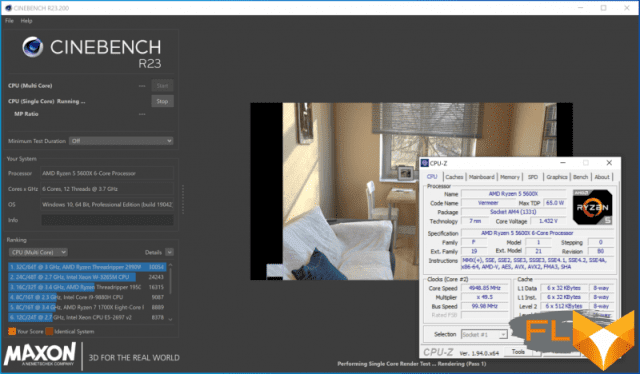
All this is shown in some detail in the graph that we built to illustrate the work of Precision Boost Override technology on the entire range of loads – from single-thread to 12-thread mode. Cinebench R23 traditionally acts as a processor loader here.
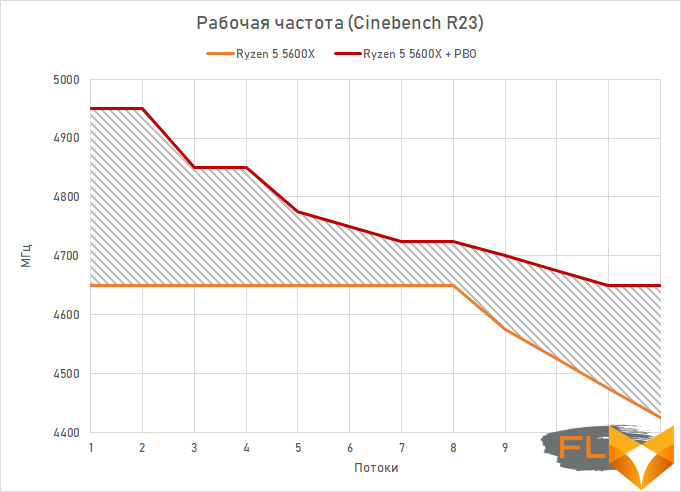
The rebirth looks very impressive, because the additional performance of the Ryzen 5 5600X is revealed in just a couple of clicks in the BIOS, and automatic overclocking is more noticeable than manual overclocking.
However, do not overestimate the potential of such overclocking. Firstly, when Precision Boost Override is enabled, the processor frequency increases by 6% at best, which means that the performance gain will be even less. Secondly, by turning on this setting, the processor turns from an energy-efficient processor into a regular one. If in the nominal mode its consumption is limited to 88 W, then the activation of automatic overclocking immediately raises its appetites by about a third – up to 120 W at full load.
⇡#Description of the test system and testing methodology
A fairly large number of devices took part in the comparative testing “Ryzen 5 5600X against everyone”. In addition to the obvious rivals of this processor – the six-core Ryzen 5 3600XT and Core i5-10600K, we had to include several more competitors in the test, which are similar to the Ryzen 5 5600X not in terms of nuclear formula, but in cost. This is how two processors with eight cores got into the tests: Ryzen 7 3700X with a recommended price of $329 and Core i7-10700 with a recommended price of $289-$323 (depending on whether we are talking about a CPU version with or without a graphics core). The background for this comparison were other characteristic representatives of the AMD Matisse and Vermeer product lines, as well as Intel Comet Lake with 8 to 12 cores.
- Processors:
- AMD Ryzen 9 5900X (Vermeer, 12 cores + SMT, 3.7-4.8GHz, 64MB L3);
- AMD Ryzen 7 5800X (Vermeer, 8 cores + SMT, 3.8-4.7GHz, 32MB L3);
- AMD Ryzen 5 5600X (Vermeer, 6 cores + SMT, 3.7-4.6GHz, 32MB L3);
- AMD Ryzen 9 3900XT (Matisse, 12 cores + SMT, 3.8-4.7GHz, 64MB L3);
- AMD Ryzen 7 3800XT (Matisse, 8 cores + SMT, 3.8-4.7GHz, 32MB L3);
- AMD Ryzen 7 3700X (Matisse, 8 cores + SMT, 3.6-4.4GHz, 32MB L3);
- AMD Ryzen 5 3600XT (Matisse, 6 cores + SMT, 3.8-4.5GHz, 32MB L3);
- Intel Core i9-10900K (Comet Lake, 10 cores + HT, 3.7-5.3GHz, 20MB L3);
- Intel Core i9-10850K (Comet Lake, 10 cores + HT, 3.6-5.2GHz, 20MB L3);
- Intel Core i7-10700K (Comet Lake, 8 cores + HT, 3.8-5.1GHz, 16MB L3);
- Intel Core i7-10700 (Comet Lake, 8 cores + HT, 2.9-4.8 GHz, 16MB L3);
- Intel Core i5-10600K (Comet Lake, 6 cores + HT, 4.1-4.8 GHz, 12MB L3).
- CPU cooler: EKWB custom coolant
- Motherboards:
- ASUS ROG Crosshair VIII Hero (Socket AM4, AMD X570);
- ASUS ROG Maximus XII Hero (Wi-Fi) (LGA1200, Intel Z490).
- Memory: 2 × 16GB DDR4-3600 SDRAM, 16-18-18-38 (Crucial Ballistix RGB BL2K16G36C16U4BL).
- Video Card: NVIDIA GeForce RTX 3080 Founders Edition (GA102, 1440-1710/19000MHz, 10GB GDDR6X 320-bit).
- Disk subsystem: Samsung 970 EVO Plus 2TB (MZ-V7S2T0BW).
- Power supply: Thermaltake Toughpower DPS G RGB 1000W Titanium (80 Plus Titanium, 1000W).
All compared processors were tested with the settings accepted by the motherboard manufacturers “by default”. This means that for Intel platforms, the power consumption limits indicated in the specifications are ignored, and instead the maximum possible frequencies are used in order to obtain maximum performance. The vast majority of users operate processors in this mode, since enabling heat dissipation and power consumption limits in most cases requires special BIOS settings. All compared processors were tested with memory operating in DDR4-3600 mode with XMP timing settings.
Testing was performed on the Microsoft Windows 10 Pro (v2004) Build 18363.476 operating system using the following driver set:
- AMD Chipset Driver 2.10.13.408;
- Intel Chipset Driver 10.1.31.2;
- NVIDIA GeForce 457.30 Driver
Description of the tools used to measure computing performance:
Comprehensive benchmarks:
- Futuremark PCMark 10 Professional Edition 2.1.2506 – testing in Essentials scenarios (typical work of the average user: launching applications, surfing the Internet, video conferencing), Productivity (office work with a word processor and spreadsheets), Digital Content Creation (creating a digital content: photo editing, non-linear video editing, rendering and visualization of 3D models).
- 3DMark Professional Edition 2.14.7042 – testing in the Time Spy Extreme 1.0 scene.
Applications:
- 7-zip 19.00 — archiving speed testing. The time taken by the archiver to compress a directory with various files with a total volume of 3.1 GB is measured. Uses LZMA2 algorithm and maximum compression ratio.
- Adobe Photoshop 2020 21.2.1 – Graphics performance testing. The average execution time of the Puget Systems Adobe Photoshop CC Benchmark 18.10 test script, which simulates the typical processing of an image taken by a digital camera, is measured.
- Adobe Photoshop Lightroom Classic 9.3 – performance test for batch processing of a series of RAW images. The test scenario includes post-processing and export to JPEG at a resolution of 1920 × 1080 and a maximum quality of two hundred 16-megapixel RAW images taken with a Fujifilm X-T1 digital camera.
- Adobe Premiere Pro 2020 14.3.1 – Non-linear video editing performance test. Measures rendering time to YouTube 4K for a project containing HDV 2160p30 footage with various effects applied.
- Blender 2.90.1 – testing the speed of the final rendering in one of the popular free packages for creating three-dimensional graphics. The duration of building the final model pavillon_barcelona_v1.2 from Blender Benchmark is measured.
- Cinebench R23 is the standard benchmark for testing rendering speed in Cinema 4D R23.
- Magix Vegas Pro 18.0 – performance testing for non-linear video editing. Measures rendering time to YouTube 4K for a project containing HDV 2160p30 footage with various effects applied.
- Microsoft Visual Studio 2017 (15.9.28) – measuring the compilation time of a large MSVC project – a professional package for creating three-dimensional graphics Blender version 2.79b.
- Stockfish 12 – testing the speed of the popular chess engine. The speed of enumeration of options in the position “1q6/1r2k1p1/4pp1p/1P1b1P2/3Q4/7P/4B1P1/2R3K1 w” is measured.
- SVT-AV1 v0.8.5 – testing the speed of video transcoding to the promising AV1 format. Performance is measured using a raw 1080p@50FPS AVC video file with a bitrate of about 30 Mbps.
- Topaz Video Enhance AI v1.7.1 – performance testing in an AI-based program to improve video detail. The test uses the original video at 640×360 resolution, which is doubled using the Artemis LQ v7 model.
- V-Ray 5.00 – Benchmark the performance of a popular rendering system using the standard V-Ray Benchmark Next application.
- VeraCrypt 1.24 – cryptographic performance testing. The benchmark built into the program is used, which uses Kuznyechik-Serpent-Camellia triple encryption.
- x265 3.4+26 10bpp – testing the speed of video transcoding to H.265/HEVC format. To evaluate performance, we use the original 2160p@24FPS AVC video file with a bitrate of about 42 Mbps.
Games:
- Assassin’s Creed Odyssey. Resolution 1920 × 1080: Graphics Quality = Ultra High. Resolution 3840 × 2160: Graphics Quality = Ultra High.
- Civilization VI: Gathering Storm. Resolution 1920×1080: DirectX 12, MSAA=4x, Performance Impact=Ultra, Memory Impact=Ultra. Resolution 3840 × 2160: DirectX 12, MSAA = 4x, Performance Impact = Ultra, Memory Impact = Ultra.
- Crysis Remastered. Resolution 1920 × 1080: Graphics Settings = Very High, RayTracing Quality = Very High, Anti-Aliasing = TSAA. Resolution 3840 × 2160: Graphics Settings = Very High, RayTracing Quality = Very High, Anti-Aliasing = TSAA.
- Far Cry New Dawn. Resolution 1920 × 1080: Graphics Quality = Ultra, HD Textures = On, Anti-Aliasing = TAA, Motion Blur = On. Resolution 3840 × 2160: Graphics Quality = Ultra, Anti-Aliasing = Off, Motion Blur = On.
- Hitman 2. 1920 × 1080 resolution: DirectX 12, Super Sampling = 1.0, Level of Detail = Ultra, Anti-Aliasing = FXAA, Texture Quality = High, Texture Filter = Anisotropic 16x, SSAO = On, Shadow Maps = Ultra , Shadow Resolution = High. Resolution 3840 × 2160: DirectX 12, Super Sampling = 1.0, Level of Detail = Ultra, Anti-Aliasing = FXAA, Texture Quality = High, Texture Filter = Anisotropic 16x, SSAO = On, Shadow Maps = Ultra, Shadow Resolution = High.
- Metro Exodus. 1920×1080 resolution: DirectX 12, Quality=Ultra, Texture Filtering=AF 16X, Motion Blur=Normal, Tesselation=Full, Advanced PhysX=Off, Hairworks=Off, Ray Trace=Off, DLSS=Off. Resolution 3840 × 2160: DirectX 12, Quality = Ultra, Texture Filtering = AF 16X, Motion Blur = Normal, Tesselation = Full, Advanced PhysX = Off, Hairworks = Off, Ray Trace = Off, DLSS = Off.
- Shadow of the Tomb Raider. Resolution 1920×1080: DirectX12, Preset=Highest, Anti-Aliasing=TAA. Resolution 3840 × 2160: DirectX12, Preset = Highest, Anti-Aliasing = Off.
- Total War: Three Kingdoms. Resolution 1920 × 1080: DirectX 12, Quality = Ultra, Unit Size = Extreme. Resolution 3840 × 2160: DirectX 12, Quality = Ultra, Unit Size = Extreme.
- Watch Dogs Legion. Resolution 1920×1080: DirectX 12, Quality=Ultra, RTX=Off, DLSS=Off. Resolution 3840 × 2160: DirectX 12, DirectX 12, Quality = Ultra, RTX = Off, DLSS = Off.
- World War Z. 1920 × 1080 resolution: DirectX11, Visual Quality Preset = Ultra. Resolution 3840 × 2160: DirectX11, Visual Quality Preset = Ultra.
In all gaming tests, the results are the average number of frames per second, as well as the 0.01-quantile (first percentile) for FPS values. The use of the 0.01-quantile instead of the minimum FPS is due to the desire to clean up the results from random bursts of performance that were provoked by reasons not directly related to the operation of the main components of the platform.
⇡#Performance in complex tests
The increase in single-core performance has allowed the new generation of Ryzen processors to noticeably strengthen their positions in tests that simulate normal user activity in office and business applications. This is clearly seen in the popular PCMark 10 benchmark, which has two scenarios of this kind. The Productivity scenario is dedicated to testing the speed of working in a word processor and spreadsheets, while the Essentials scenario measures the speed of application launch, browser operation, and web conferencing. And in both cases, the new Ryzen, including the six-core Ryzen 5 5600X, is beyond competition. Consequently, AMD processors have now become the preferred choice for office work.
As for the third scenario, Digital Content Creation, it is dedicated to multi-threaded resource-intensive workloads – photo and video editing, as well as 3D rendering and visualization. In this case, the number of cores begins to play a significant role, and the Ryzen 5 5600X descends into the middle part of the chart. However, this does not prevent him from continuing to overtake octa-cores from both the Matisse family and the Comet Lake family, which serves as another confirmation of the superiority of the Zen 3 microarchitecture.
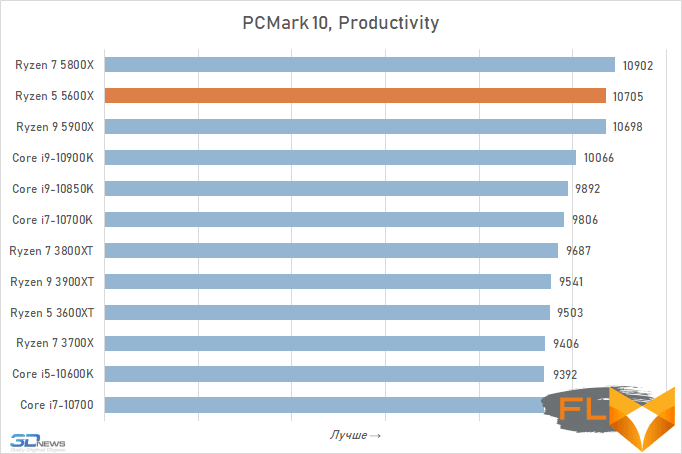
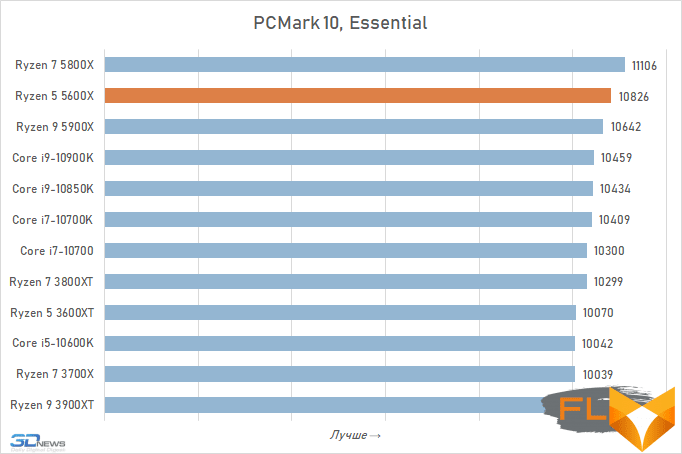

The 3DMark Time Spy test simulates some hypothetical game load, which (unlike real games) is well optimized for multithreading and uses modern vector instruction sets. In this synthetic benchmark, the Ryzen 5 5600X is the fastest of the six-core CPUs, but processors with a large number of cores, albeit not with such an advanced microarchitecture, are still ahead of it.
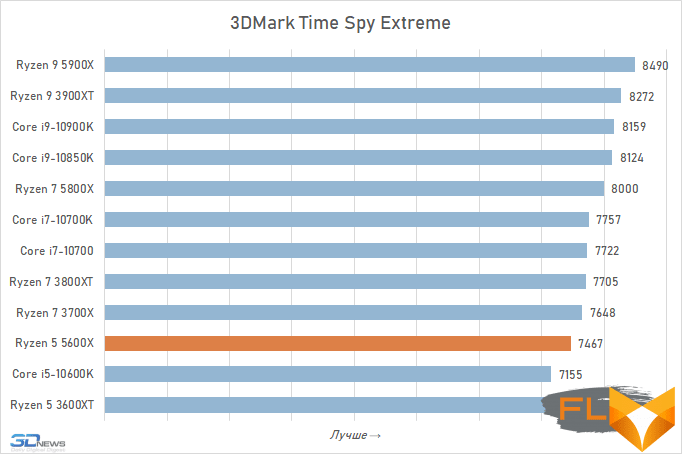
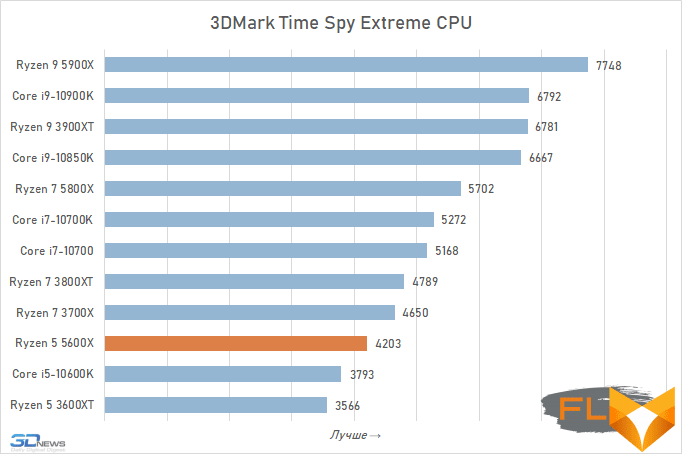
⇡#Application Performance
AMD processors had no problems with performance in resource-intensive applications even at the last stage of microarchitecture development, and with the transition to Zen 3, the advantage over Intel’s offerings increased noticeably. In terms of average performance, which we can calculate based on the results of tests in 14 different tasks, the Ryzen 5 5600X is faster than its six-core predecessor, the Ryzen 5 3600XT, by about 16%. At the same time, the advantage over the six-core Comet Lake, Core i5-10600K, is 20%.
At the same time, there are individual applications in which the Intel solution is still faster, for example, with three-step encryption or in the case of video processing using AI, but such tasks are in the clear minority. Overall, the Ryzen 5 5600X is the fastest six-core processor currently on the market.
However, it is necessary to make a reservation that AMD’s current pricing policy puts the Ryzen 5 5600X on par with octa-cores. And with such a comparison, today’s main character no longer seems like a clear winner. Even comparing the Ryzen 5 5600X to the Ryzen 7 3700X, the octa-core Zen 2 is still slightly faster as it wins in more tests. A similar situation develops if the Ryzen 5 5600X is compared with the Core i7-10700. The younger eight-core Comet Lake looks preferable, yielding to the six-core Ryzen 5 5600X only in image processing, compilation and video editing in Vegas Pro.
It turns out that AMD is a little more optimistic about its new six-core CPU than it should be, based on its performance in content creation and processing applications. For workloads, it is not very profitable, here you can get better performance if you build a system not on a new processor with a progressive microarchitecture, but on one of the chips of past generations, but with a large number of computing cores.
Rendering:

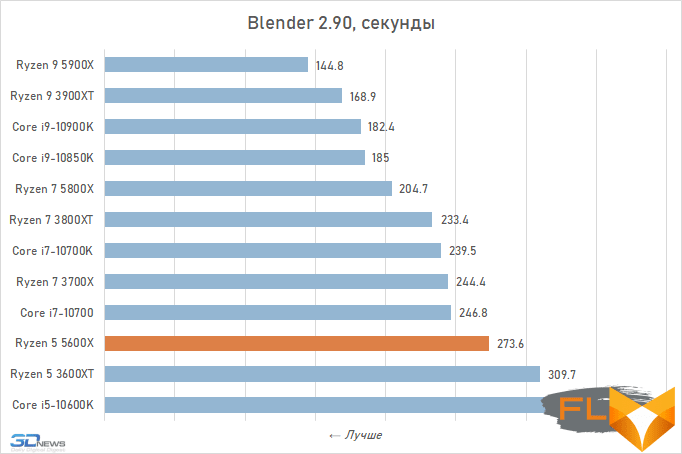

Photo processing:
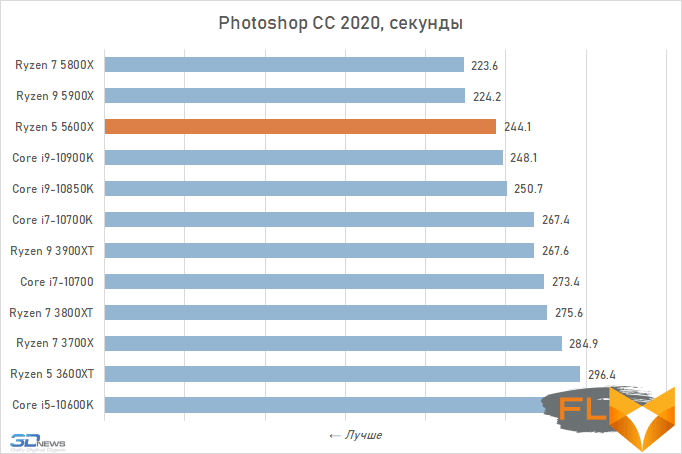
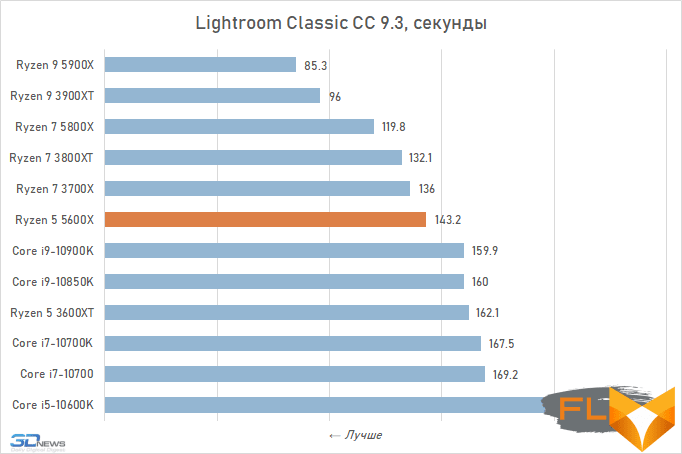
Video work:
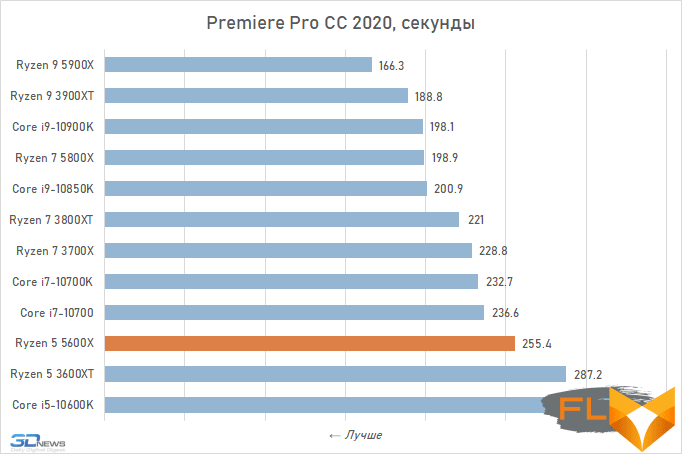
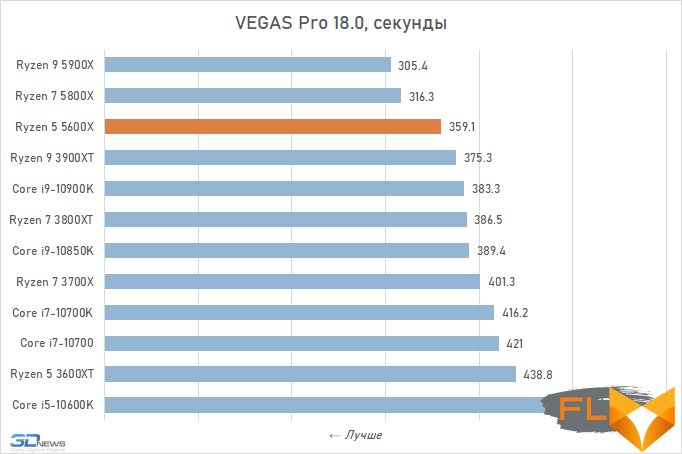

Video transcoding:
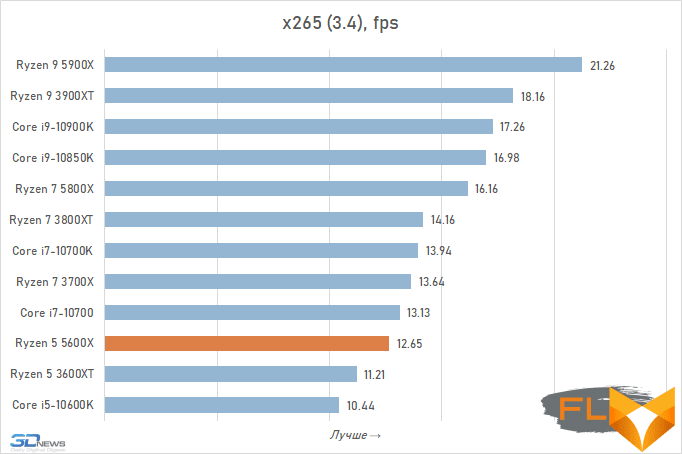

Compilation:
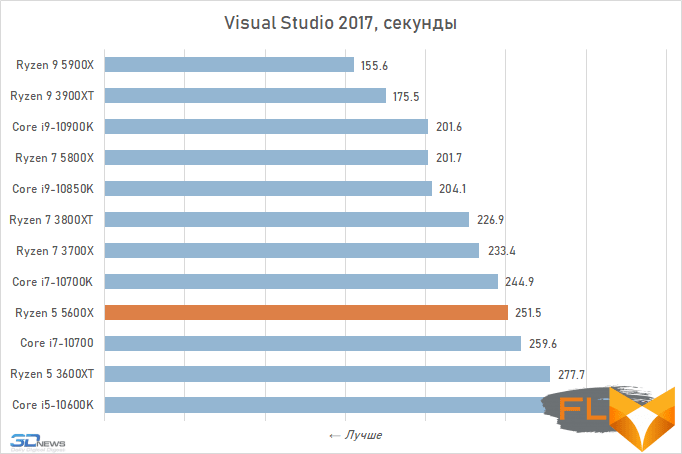
Archiving:
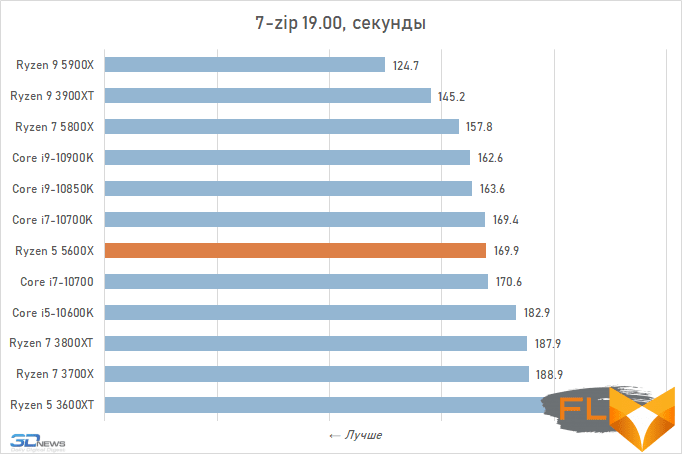
Chess:
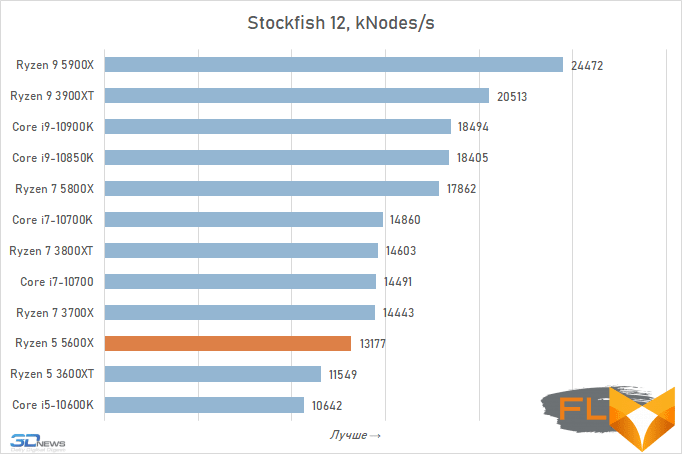
Encryption:

⇡#Performance in games. Tests in 1080p
It is generally accepted that six cores is the optimal set for modern gaming applications, so the Ryzen 5 5600X seems to be almost an ideal gaming model in the above-average price segment. And this is partly true – at a price of $ 300 in terms of gaming performance, it is comparable both with the older processors of the Comet Lake family, which were considered the “best gaming” a couple of months ago, and with representatives of the Ryzen 5000 series with eight cores and more.
At the same time, the Ryzen 5 5600X turns out to be significantly more productive than any AMD processor of the past generation. Its average frame rate advantage over the same Ryzen 7 3600XT is 17%. It also outperforms Intel’s six-core alternative, the Core i5-10600K processor. In this case, the advantage, although not so overwhelming, is still quite noticeable – about 7%. To properly characterize the gaming performance of the Ryzen 5 5600X, it is best to draw parallels with the octa-core Core i7-10700 and Core i7-10700K. AMD’s hexa-core still slightly outperforms them in average FPS most of the time, but Intel’s processors can counter with a slight advantage in minimum frame rates.
All this is easy to see in the following graph, which we built by summarizing the performance indicators for ten games.

Ultimately, the Ryzen 5 5600X does indeed prove to be a good option for gaming builds, and in this application it performs better than any other modern six-core processor. True, it should be noted separately that Intel supporters who prefer to use configurations based on the Core i7-10700 processor and a motherboard based on the Z490 chipset (providing support for fast memory) will not lose much.
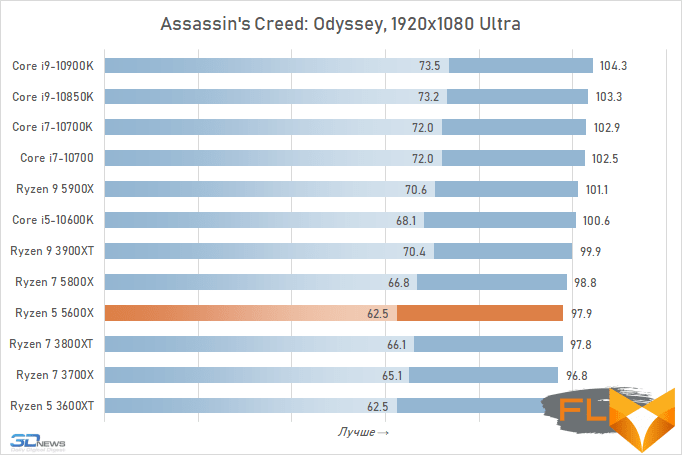

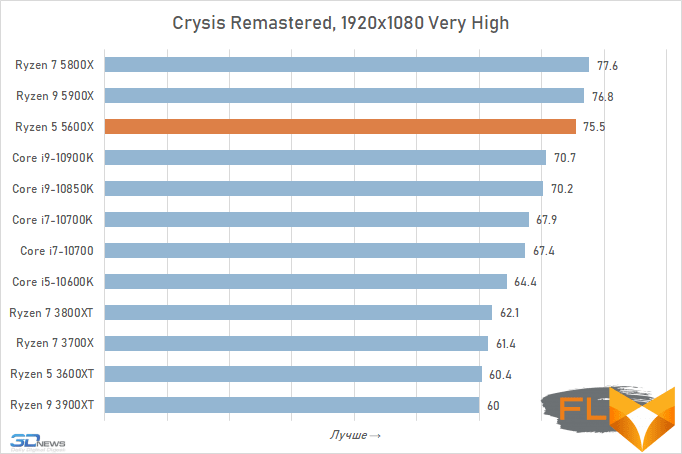
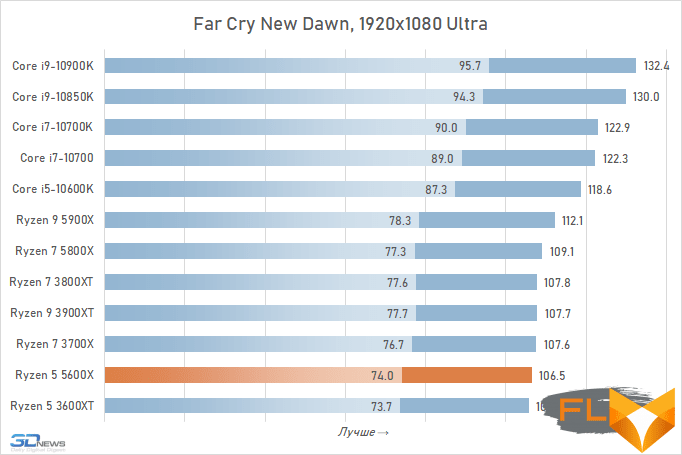
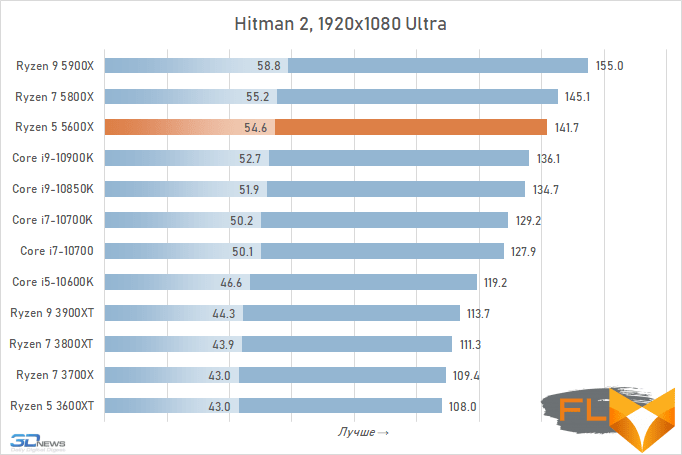
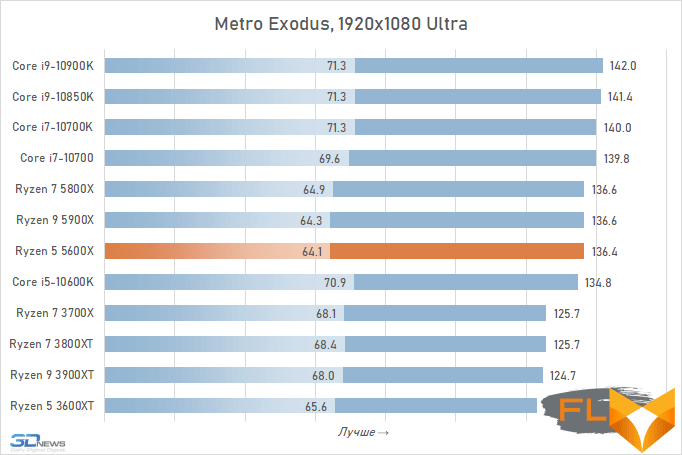

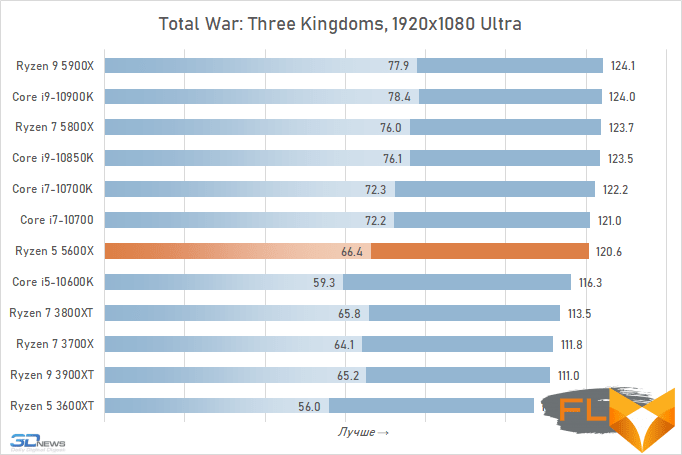
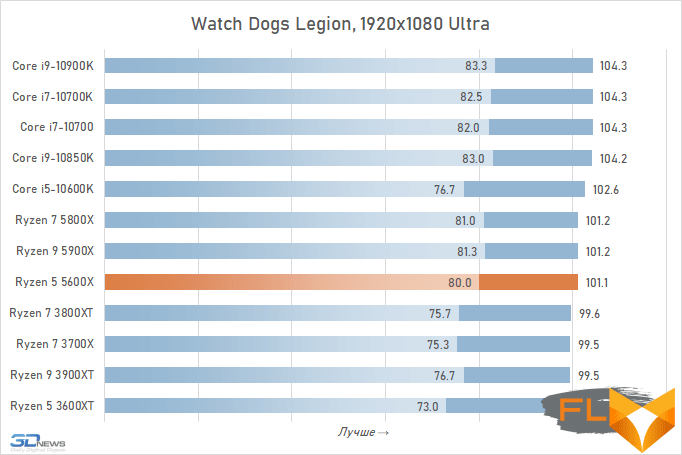
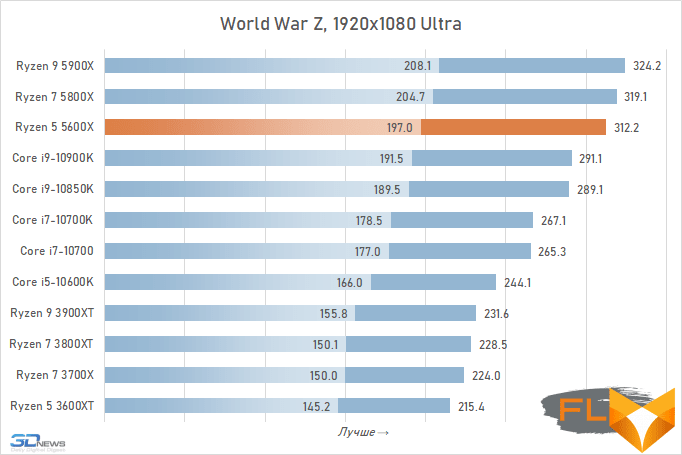
⇡#Performance in games. Tests in 2160p
Testing in 4K resolution is more a tribute to tradition than a real need. It is quite obvious that increasing the resolution transfers a significant part of the load to the graphics subsystem, due to which the influence of processors on the frame rate is noticeably reduced. Therefore, the main thing that we can see in this section is that for high resolutions, you can take any of the processors participating in the tests: with current video cards, there is no lack of computing performance.
In the context of high resolutions, we can only talk about the prospects of one or another CPU variant with an eye on future video subsystem upgrades. But in this case, it is better to focus on gaming performance indicators in FullHD – they give a more visual idea of how CPUs cope with gaming loads, when something really depends on their power.
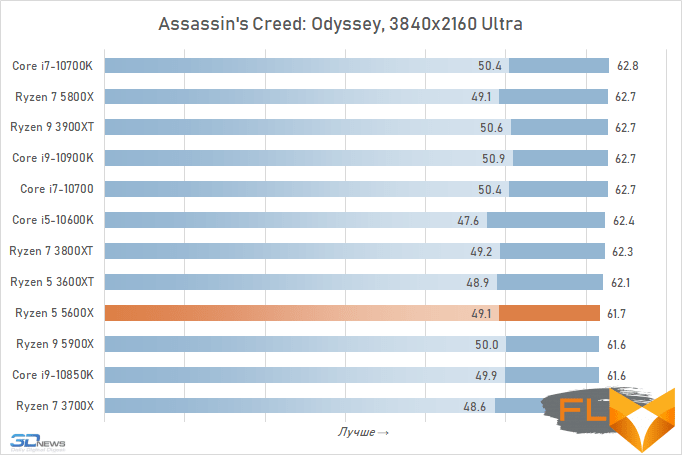
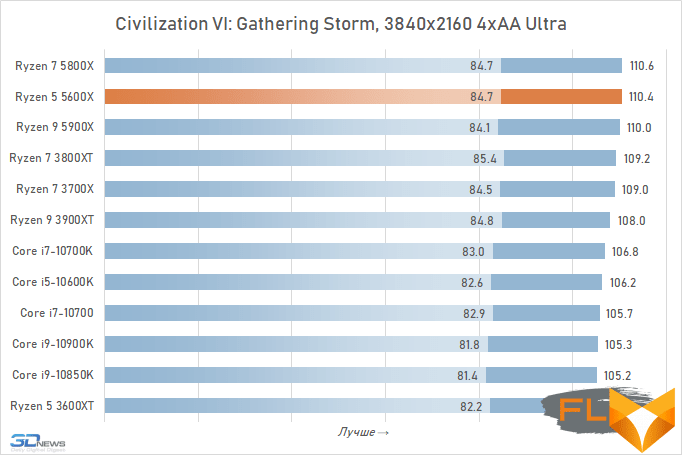
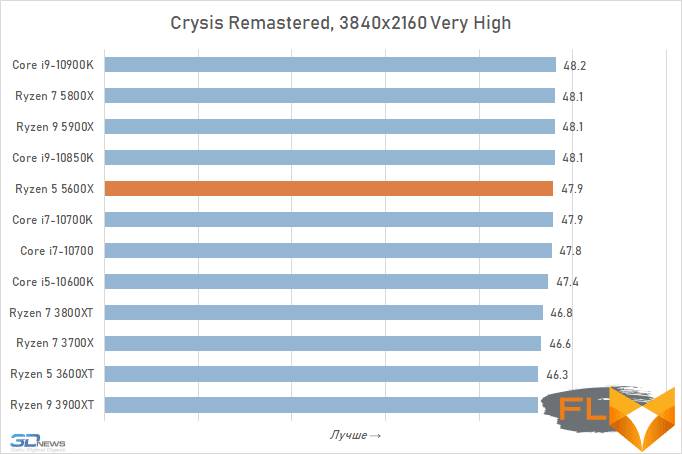
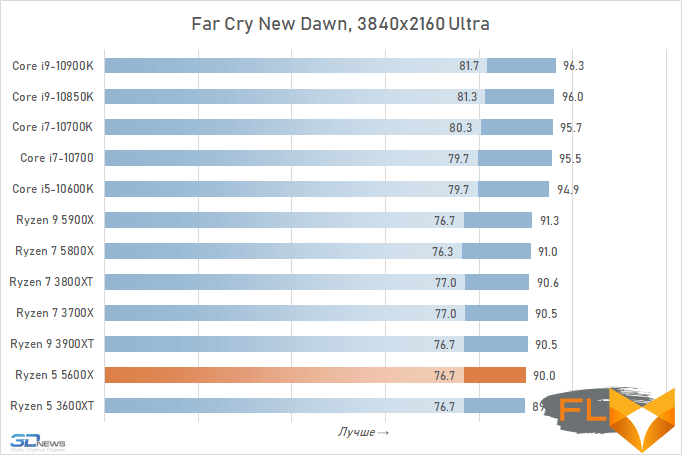
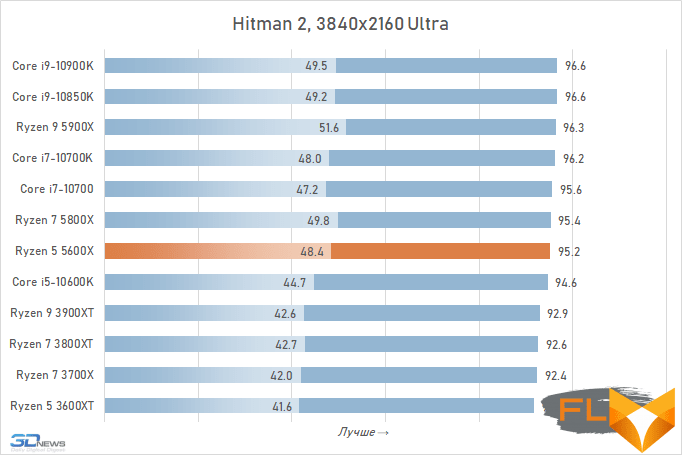
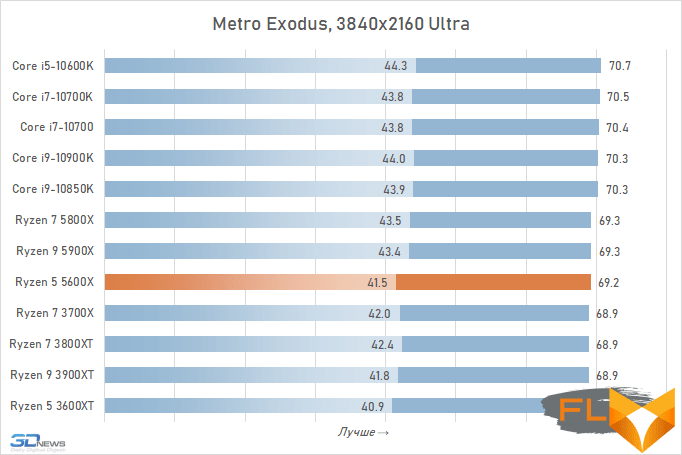
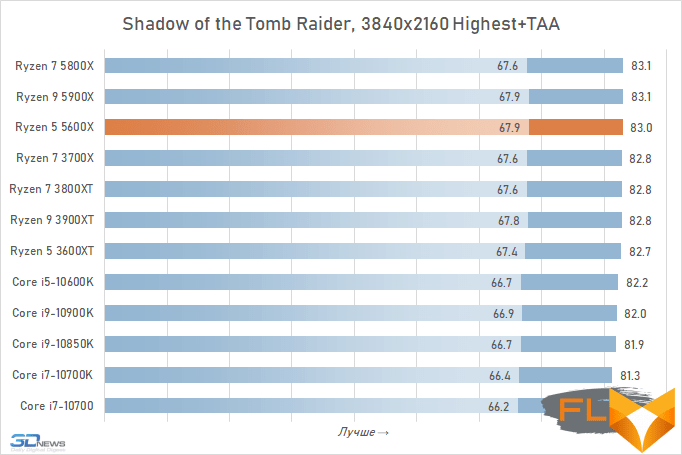
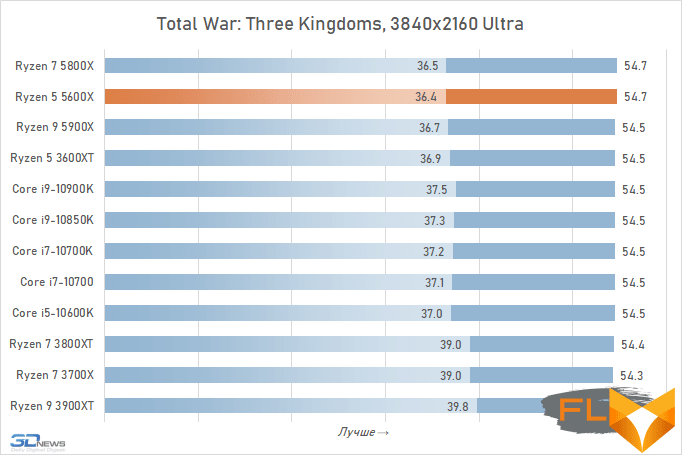
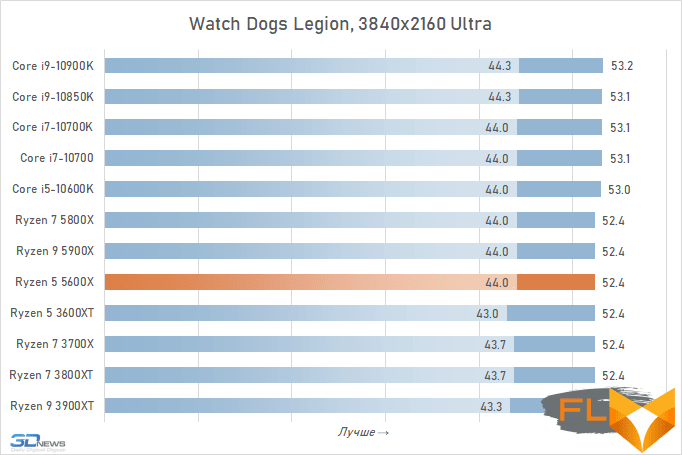
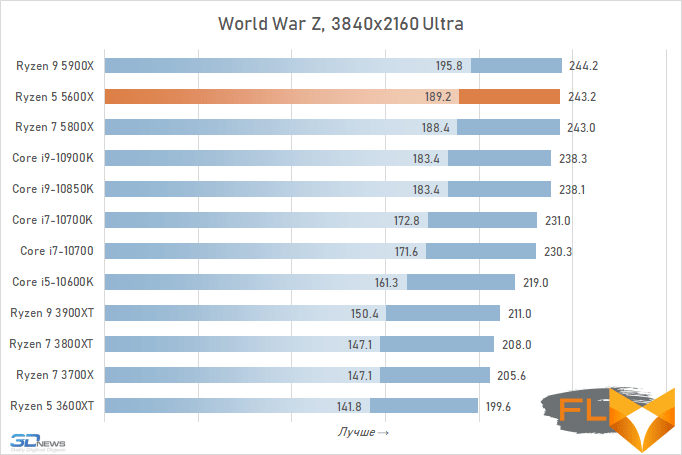
⇡#Energy Consumption
Ryzen 5 5600X is noticeably different from its counterparts in energy efficiency, even in passport specifications. It has a TDP of 65W instead of 105W, and maximum power consumption is capped at 88W instead of 142W. This is naturally reflected in the overall consumption of the entire system, which, when using the Ryzen 5 5600X instead of, for example, the Ryzen 7 5800X, will be several tens of watts more economical at full load.
System consumption based on Ryzen 5 5600X is also lower when compared to similar configurations based on Intel processors. Even in a load that does not generate AVX instructions that are contraindicated for processors with the Skylake microarchitecture, the Ryzen 5 5600X looks better in terms of consumption than the six-core Core i5-10600K.
But it is more significant to compare the consumption of systems on the Ryzen 5 5600X and Core i7-10700, since they showed a similar result in the multi-threaded performance test in Cinebench R23. Such a comparison inevitably leads to the conclusion that in terms of specific performance per watt, the Zen 3 microarchitecture outperforms Skylake by about one and a half times.
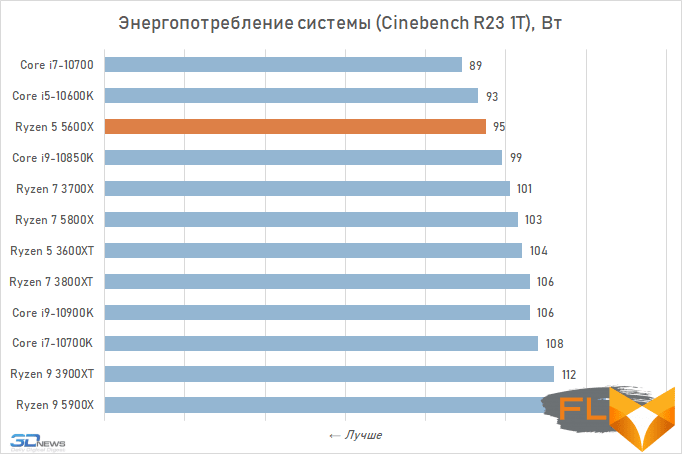

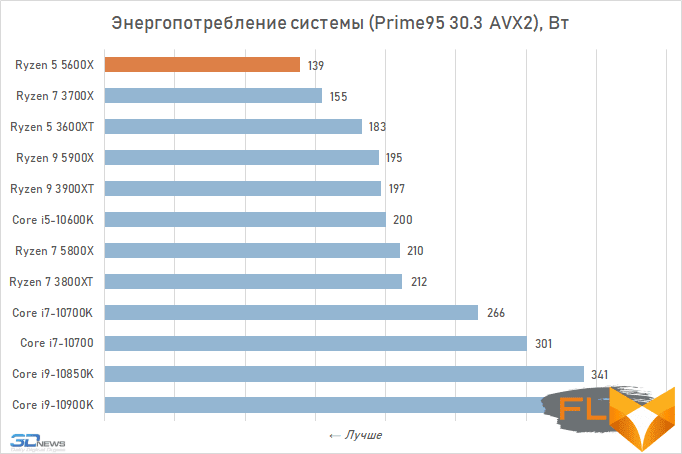
⇡#Conclusions
There are several articles published on our website where we reasonably praise Zen 3. Familiarity with various processors of the Ryzen 5000 series invariably leads to the same conclusion: the fourth iteration of the current AMD microarchitecture turned out to be very successful, and the processors based on it can be safely called the best in terms of technology solutions from all the options currently available on the market. The six-core Ryzen 5 5600X is no exception. In it, we once again saw all the trump cards of Zen 3 in action, starting with a noticeably increased specific performance per clock and ending with increased clock frequencies and a single CCX complex for the entire processor. All this allows us to call the Ryzen 5 5600X the most interesting CPU among all six-core processors. Compared to the Ryzen 5 3600XT and Core i5-10600K, it is able to offer both better performance and superior energy efficiency in tests. And this applies to the entire spectrum of tasks, including office applications, applications for content creation, as well as 3D games.
However, this is still not enough for the Ryzen 5 5600X to deserve unequivocal recommendations. The fact is that when introducing the Ryzen 5000 family to the market, AMD significantly raised prices, as a result of which the six-core processor considered in this review compared to the older six-core of the previous series, the Ryzen 5 3600XT, has risen in price by as much as 20%. The positioning of the novelty has changed dramatically from this, and it actually fell into a more “heavy” weight category – in the company of eight-cores. Frankly, the six-core Ryzen 5 5600X, enhanced by the Zen 3 microarchitecture, does not look like an outsider when compared with equal-priced rivals with a large number of cores, such as the Ryzen 7 3700X or the Core i7-10700. But in this case, we are more likely to have to talk about either approximate equality, or a slight lag in performance, but certainly not some noticeable superiority.
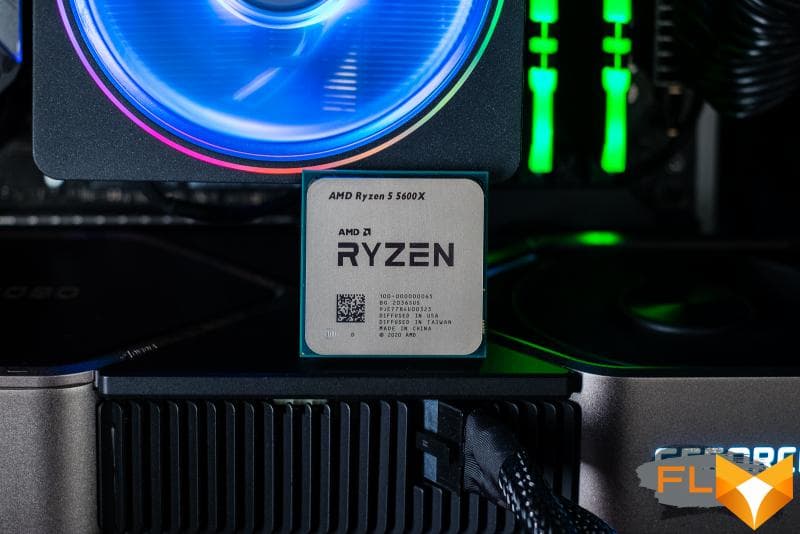
In the end, it turns out that the Ryzen 5 5600X is a good $ 300 processor, which is well worth the money. But to say that in its price segment it is definitely better than the available alternatives is still unjustified. In many situations, similarly priced eight-core processors will be a more suitable choice, and therefore there is not much point in chasing the Ryzen 5 5600X. Especially now, when you need to race in the literal sense – there are no fresh-generation processors on free sale, and when they appear, their prices are terribly far from the $300 indicated by the manufacturer.
Still, the Ryzen 5 5600X deserves to be looked at when it does become available at the manufacturer’s advertised price. Indeed, in addition to superiority over any other six-core processor, the Ryzen 5 5600X has two more valuable properties. Firstly, it is very energy efficient and surpasses any other models with comparable performance in this characteristic. Secondly, it can be effectively overclocked. Of course, we are not talking about a noticeable increase in performance, but it will allow you to raise the frequency by a couple of hundred megahertz without much resistance.
However, all such arguments would sound clearly more convincing if AMD offered something similar to the Ryzen 5 5600X, but cheaper. We sincerely hope that the Ryzen 5000 lineup will not be limited to the four models presented at the moment. And when the company releases a six-core processor simpler than the Ryzen 5 5600X reviewed today, the task of choosing the optimal processor in the middle price segment can get a more obvious solution.


